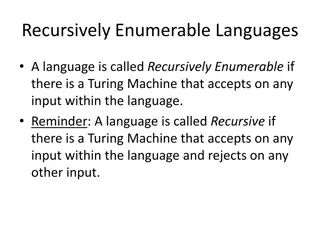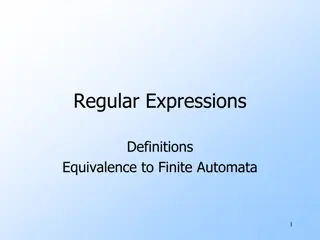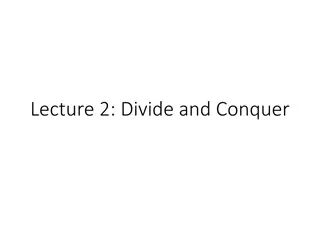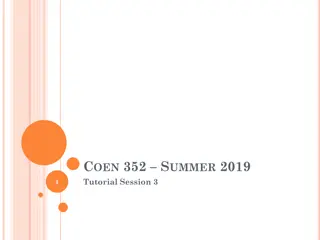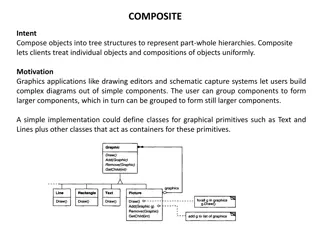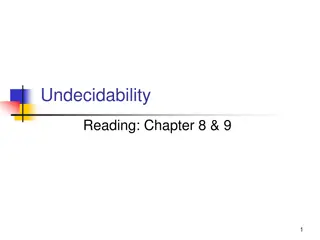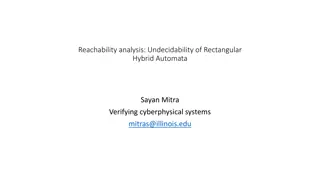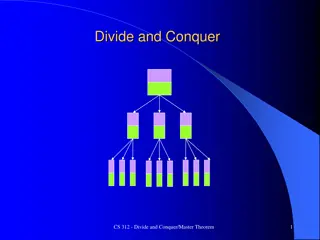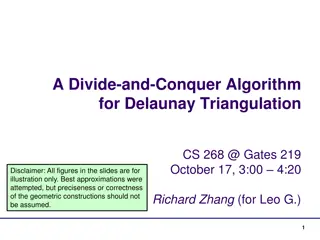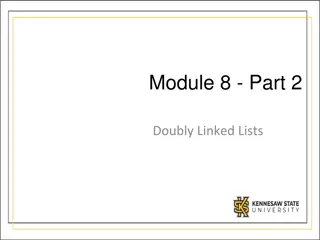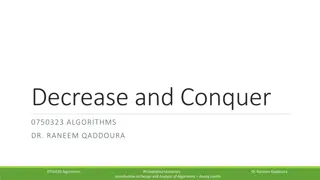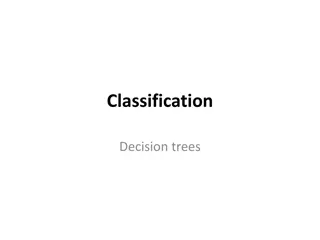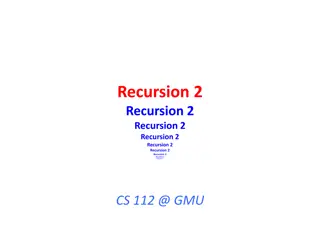Implementing Minimum Number Finding Algorithm in Python
The algorithm aims to find the minimum and second minimum numbers in an array using Python. Additionally, it discusses finding the nth smallest number in an array recursively along with the running time analysis. The content includes code snippets and explanations for better understanding.
0 views • 22 slides
Understanding Recursive vs Recursively Enumerable Languages
Comparison between recursive and recursively enumerable languages in terms of Turing Machines acceptance, decidable languages, recognizable languages, and partial predicates. Explains the concepts with examples and how Turing Machines decide membership in languages.
0 views • 8 slides
Understanding Chomsky Hierarchy in Language Theory
Explore Chomsky Hierarchy in language theory, including different types of languages, grammars, and automata. Learn how to prove if a language is regular, context-free, recursive, or recursively enumerable. Understand the closure properties of regular, context-free, recursive, and recursively enumer
2 views • 10 slides
Equivalence of Regular Expressions and Finite Automata
Regular expressions are an algebraic method to describe languages, specifically the regular languages. They are defined recursively based on symbols and operations such as concatenation and closure. Precedence rules and examples are also provided. The equivalence between regular expressions and fini
0 views • 25 slides
Bi-Decomposition of Large Boolean Functions Using Blocking Edge Graphs
Bi-decomposition is a vital technique in logic synthesis for restructuring Boolean networks. This paper discusses the methodology of breaking down large Boolean functions using Blocking Edge Graphs (BEG) to simplify physical design and reduce complexity. The process involves constructing BEG, perfor
1 views • 29 slides
Algorithm Design Techniques: Divide and Conquer
Algorithm design techniques such as divide and conquer, dynamic programming, and greedy algorithms are essential for solving complex problems by breaking them down into smaller sub-problems and combining their solutions. Divide and conquer involves breaking a problem into unrelated sub-problems, sol
1 views • 13 slides
Introduction to Divide and Conquer Algorithms
Explore the Divide and Conquer method in algorithm design, focusing on Mergesort as a fast sorting recursive algorithm. Learn how to divide input into smaller parts, solve them recursively, and merge the results to obtain the final solution. Dive into the key ideas, steps, and intricacies of Merge o
2 views • 59 slides
Introduction to QuickSort Algorithm
Explore the QuickSort algorithm with details on the worst-case time complexity, partitioning process, recursive method, and example scenarios. Understand how QuickSort efficiently sorts arrays by choosing a pivot, comparing elements, and recursively partitioning the array until sorted. Dive into the
0 views • 19 slides
Understanding the Composite Design Pattern in Object-Oriented Programming
The Composite design pattern allows clients to treat individual objects and compositions of objects uniformly, enabling the representation of part-whole hierarchies in tree structures. This pattern is commonly used in graphics applications to create complex diagrams from simple components, allowing
0 views • 43 slides
Understanding Recursive and Recursively Enumerable Languages
Exploring the concepts of decidability and undecidability in computer science, specifically focusing on Recursive and Recursively Enumerable (RE) languages. Recursive languages always halt, while RE languages may or may not halt, showcasing the differences between decidable and undecidable problems.
0 views • 35 slides
Undecidability in Rectangular Hybrid Automata Analysis
The undecidability of the reachability analysis in rectangular hybrid automata (RHA) poses challenges for verifying cyber-physical systems. This complexity was demonstrated through a reduction from the Halting problem of two counter machines by Henzinger et al. Additionally, the review of computabil
0 views • 15 slides
Understanding the Divide and Conquer Technique in Computer Science
The Divide and Conquer approach is a powerful strategy used in computer science to break down large problems into smaller, more manageable subproblems. By recursively solving these subproblems and combining their results, this technique offers a structured way to tackle complex tasks efficiently. Th
1 views • 59 slides
Divide-and-Conquer Algorithm for Delaunay Triangulation
Delaunay triangulation using a divide-and-conquer approach involves sorting input sites, dividing them into halves, recursively building Delaunay for each half, adding cross edges between the halves, and recombining by removing certain edges. Key steps include building cross edges in linear time and
2 views • 48 slides
Understanding Divide and Conquer Algorithm for Maximum Subarray Sum
Explore the concept of divide and conquer in solving the maximum contiguous subarray sum problem. Learn how to split the array, solve parts recursively, and combine answers efficiently. Discover the limitations of a brute force approach and delve into edge cases to optimize your algorithm. Conquer t
0 views • 26 slides
Understanding Doubly Linked Lists in Data Structures
Doubly linked lists contain nodes with both forward and backward links, allowing traversal in both directions. The nodes can be inserted or deleted at the beginning, middle, or end, requiring updating of links accordingly. Additionally, a recursive method can be used to manipulate data in each node,
0 views • 17 slides
Understanding Decrease and Conquer Technique in Algorithms
The decrease-and-conquer technique in algorithms leverages the relationship between a problem instance and its smaller instances to solve problems effectively. It involves decreasing by one, half, or a constant factor to iteratively solve problems. This method can be implemented recursively or itera
1 views • 9 slides
Exploring Divide and Conquer Paradigm in Algorithm Design
Discover the Divide and Conquer approach in algorithm design through concepts like Merge Sort and Counting Inversions. Learn how to split instances into subparts, solve them recursively, and combine the answers to optimize algorithm efficiency.
1 views • 43 slides
Understanding Divide and Conquer Algorithms in Computer Science
In the recent lecture, we revisited topics such as the exam review, data compression, and mergesort. We also delved into a captivating puzzle set on the planet Og, exploring the logic behind truth-telling and lying natives. Furthermore, we discussed the transformation of recursive functions into non
2 views • 36 slides
Understanding Decision Trees in Classification
Decision trees are a popular machine learning algorithm for classification tasks. They consist of nodes representing conditions, branches indicating decisions, and leaves representing outcomes. By choosing the best attribute and splitting data recursively, decision trees can efficiently classify dat
0 views • 47 slides
Understanding Recursion: A Fundamental Concept in Computer Science
Recursion is a fundamental concept in computer science that involves solving problems by breaking them down into smaller, similar subproblems. This content delves into the basics of recursion, highlighting key components such as the recursive case and base case. It also explores the concept of facto
0 views • 35 slides

